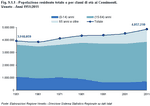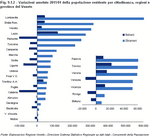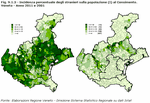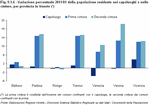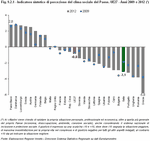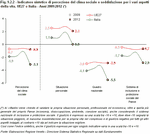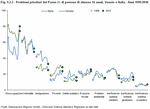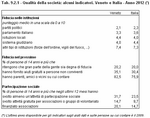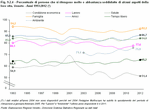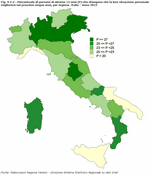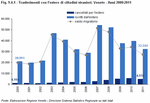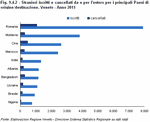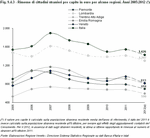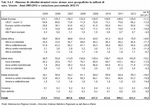Chapter 9
Strategies for the family: reviewing priorities and responses
There is now no doubt that today represents a time of transformation, also social, and in just a few months not only a general awareness of the particular historical moment has changed, but also of the need and sensitivity to adapt responses, life styles and personal/collective choices in these new conditions.
When faced with a multitude of effects and catalysts, the orientation towards statistical information, which, even from an individual standpoint, is socially valid, is not easy, given the complexity, speed and apparent contradictory nature of some phenomena and "physiological" times required to process data. However, there is certainly a need to gather the most evident aspects in the manifold reactions and responses of people, families and communities.
In 2011 the 15th National Census of the population and homes was conducted, to totally review the demographic map and macro changes that have occurred over the last ten years, providing answers not only to questions such as "how many of us are there?" but also "who are we?" and where and how we live. These choices are increasingly often dictated by work and salary, deciding whether to live in a city centre or on the outskirts, whether to start a family, study or work abroad, but are also linked to social climate, and the combination of satisfaction with the present and faith in the future.
The advent of new poverty and increase in inequality are now regular headlines, also changing the features of communication, but the social body also responded to the costs of the crisis with a firm grounding from the very start, based, as underlined by the Census in its last report (Note 1), on "staying power" -in other words the ability to recover and improve on all that has remained operative from previous development processes - to then demonstrate the ability to change, and find new directions in reviewing priorities and responses. Restraint is one of the terms that has now come back into fashion, also when reporting consumption with a non-competitive logic of need and not of status, where solidarity and the renewed will for being part of a community are both starting to take root. The foreign presence, which in this situation risks being experienced only in terms of conflict, is still today considered, as emerges from a survey by ISTAT (Note 2), in an ambivalent way, with some seeing it as "excessive" (65.2% of interviewees) and others backing rights to administrative vote (42,6%) and recognition of citizenship for children born in Italy (72.1%). And it is the foreigners themselves, who in this predicament suffer most acutely from the drama of increasing unemployment, are however optimistic and share the growing general commitment to build up solid relationships and networks. For all, alongside real sacrifices, weighted decisions and cautious personal strategies of consumption and saving, the enhancement of personal social capital seems to be an elective and virtuous means in an attempt to keep personal status more or less unchanged.
When faced with a multitude of effects and catalysts, the orientation towards statistical information, which, even from an individual standpoint, is socially valid, is not easy, given the complexity, speed and apparent contradictory nature of some phenomena and "physiological" times required to process data. However, there is certainly a need to gather the most evident aspects in the manifold reactions and responses of people, families and communities.
In 2011 the 15th National Census of the population and homes was conducted, to totally review the demographic map and macro changes that have occurred over the last ten years, providing answers not only to questions such as "how many of us are there?" but also "who are we?" and where and how we live. These choices are increasingly often dictated by work and salary, deciding whether to live in a city centre or on the outskirts, whether to start a family, study or work abroad, but are also linked to social climate, and the combination of satisfaction with the present and faith in the future.
The advent of new poverty and increase in inequality are now regular headlines, also changing the features of communication, but the social body also responded to the costs of the crisis with a firm grounding from the very start, based, as underlined by the Census in its last report (Note 1), on "staying power" -in other words the ability to recover and improve on all that has remained operative from previous development processes - to then demonstrate the ability to change, and find new directions in reviewing priorities and responses. Restraint is one of the terms that has now come back into fashion, also when reporting consumption with a non-competitive logic of need and not of status, where solidarity and the renewed will for being part of a community are both starting to take root. The foreign presence, which in this situation risks being experienced only in terms of conflict, is still today considered, as emerges from a survey by ISTAT (Note 2), in an ambivalent way, with some seeing it as "excessive" (65.2% of interviewees) and others backing rights to administrative vote (42,6%) and recognition of citizenship for children born in Italy (72.1%). And it is the foreigners themselves, who in this predicament suffer most acutely from the drama of increasing unemployment, are however optimistic and share the growing general commitment to build up solid relationships and networks. For all, alongside real sacrifices, weighted decisions and cautious personal strategies of consumption and saving, the enhancement of personal social capital seems to be an elective and virtuous means in an attempt to keep personal status more or less unchanged.
On 9th October 2011, the date of the 15th General Census of the Population and Households conducted by ISTAT, 59,433,744 people lived in Italy. The census population (published in the Ordinary Supplement n. 209 to the Official Journal 294 of 18th December 2012) becomes a legal reference for Italy through to the next census and is therefore defined as the "legal population". With respect to the census of 2001 an increase in the population of 4.3% was recorded: substantial increases are noted above all in the northern and central regions, unlike the municipalities of the south and the islands, where the number of residents has decreased. In the Veneto region, the legal population reached 4,857,210 inhabitants, approx. 329,500 more people compared to ten years previously, equal to an increase of 7.3%, one of the greatest increases recorded in Italy.
The Census provides useful information for updating municipal records on resident populations, enabling the removal of those no longer available at the time of the Census and the registration of new residents. On the basis of recent revisions to municipal records, and taking into account demographic movements in the last few months of the year, at the end of 2011 the resident population in the Veneto region fell to 4,853,657 inhabitants, of whom 458,930 were foreign.
Thanks to the Census data, it is possible to trace back through the demographic history of Italy in this long period, noting the evolution, not only in terms of quantity, but also from a structural point of view, in order to understand how society is changing, whether it is ageing, becoming more multi-ethnic, more mobile, more educated.
The dynamics of birth rates, death rates, and migration flows show important changes in the profile, according to the age of the population, which since the Second World War to today, is progressively older, both in the Veneto region and in Italy as a whole. The proportion of young people is constantly in decline, to the extent that, while in 1951 people under the age of 15 amounted to 28% of the population, the same value now has fallen to 14%; on the contrary, there is a significant increase in the elderly, from 7.7% in 1951 to 20.6% in 2011. The highest percentages of elderly people are found in the provinces of Belluno, Rovigo and Venezia, zones deemed less attractive from an economic point of view, where the more active groups of the population tend to move away to work or study elsewhere.
On a provincial level, with respect to 2001, the population has increased notably in Treviso (+10%), Verona, Padua and Vicenza, while it has stayed virtually the same in Belluno and Rovigo. (Figure 9.1.1)(Table 9.1.1)
The Veneto region also faces this phenomena; in 10 years, the foreign population has increased by 304,254, reaching a total of 9.4% of the population (457,328 people, an increase of 198.8%), while the number of Italians has increased by a mere 25,262 (0.6%). In 2001 the immigrants represented just 3.4 of the population. The highest proportion of foreigners in the overall population remains in Treviso, Verona and Vicenza (over 10%), but Padua shows the highest increase (from 2.6% al 9.1% of the population, a whole 6.5 percent higher). These are provinces that offer more employment opportunities; the ten years between the two censuses have proved to be flourishing for economic trade in our region, showing the region's ability over this period to attract and retain foreign citizens seeking employment here. The global economic crisis, which since 2009 has also affected the Veneto region, has however meant that these dynamics have slowed down significantly: in the two-year period 2009-2010 the number of foreigners increased on average by 5.4% per year, compared to increases of over 10% in previous years. (Figure 9.1.3)
On the other hand, since 2001 the Veneto region has seen a gradual repopulation of some main cities, such as Vicenza (+4%), Belluno (+1.5%), Treviso (+1.1%) and Padua (+0.6%). The engines behind this new centripetal force are on the one hand the phenomena of large immigrant flows, seeing new foreign citizens occupying first the larger urban centres, to then move to surrounding municipalities, and on the other hand the work to improve urban areas, with the commitment of many cities with an aim to regain attraction. The municipalities of Rovigo and Verona in the meantime remain stable, while Venice varies over time (-3.6%).
Despite the recent recovery of a number of main cities, the peripheral areas of cities in the Veneto region still show greater powers of attraction, more so than the cities. This applies especially to the case of the provinces in the central section of the region, with more economic and employment potential. These municipalities are those that have most increased their population in the last ten years.
In the future, the accessibility and enjoyability of cities will be key factors for populating urban centres: everything will depend on not only economic and employment developments, but also the efficiency of transport infrastructures and the cost of living. The promotion of sustainable urban development is one of the priorities also in European Union policies, which recognise the role of the city as the driving force behind growth and development in boosting incentive in competition and cohesion. (Figure 9.1.4)
The Census provides useful information for updating municipal records on resident populations, enabling the removal of those no longer available at the time of the Census and the registration of new residents. On the basis of recent revisions to municipal records, and taking into account demographic movements in the last few months of the year, at the end of 2011 the resident population in the Veneto region fell to 4,853,657 inhabitants, of whom 458,930 were foreign.
Thanks to the Census data, it is possible to trace back through the demographic history of Italy in this long period, noting the evolution, not only in terms of quantity, but also from a structural point of view, in order to understand how society is changing, whether it is ageing, becoming more multi-ethnic, more mobile, more educated.
The dynamics of birth rates, death rates, and migration flows show important changes in the profile, according to the age of the population, which since the Second World War to today, is progressively older, both in the Veneto region and in Italy as a whole. The proportion of young people is constantly in decline, to the extent that, while in 1951 people under the age of 15 amounted to 28% of the population, the same value now has fallen to 14%; on the contrary, there is a significant increase in the elderly, from 7.7% in 1951 to 20.6% in 2011. The highest percentages of elderly people are found in the provinces of Belluno, Rovigo and Venezia, zones deemed less attractive from an economic point of view, where the more active groups of the population tend to move away to work or study elsewhere.
On a provincial level, with respect to 2001, the population has increased notably in Treviso (+10%), Verona, Padua and Vicenza, while it has stayed virtually the same in Belluno and Rovigo. (Figure 9.1.1)(Table 9.1.1)
There are more of us thanks to foreigners
In the period between censuses 2001 and 2011, it is above all the contribution of the foreign population that positively influences the overall variation in number of residents, softening any sharp decreases and increasing earnings. On a national level, while foreign residents have increased by 201.8%, the number of Italians has remained basically stable (-0.5%). The same can be said when comparing regional dynamics: the foreign population has increased in all Italian regions, with variations constantly above 150%. A very different case must be said of the Italians, where the maximum growth recorded on a regional scale was less than 4%, with even frequent cases of this percentage falling to negative figures. One explanation of this strong increase in foreign residents, as recorded in the census, is the emergent effect of the "amnesties" over this decade and the inclusion of Romania and Bulgaria in the European Union, counting for more than 20% of the immigrants to Italy. (Figure 9.1.2)The Veneto region also faces this phenomena; in 10 years, the foreign population has increased by 304,254, reaching a total of 9.4% of the population (457,328 people, an increase of 198.8%), while the number of Italians has increased by a mere 25,262 (0.6%). In 2001 the immigrants represented just 3.4 of the population. The highest proportion of foreigners in the overall population remains in Treviso, Verona and Vicenza (over 10%), but Padua shows the highest increase (from 2.6% al 9.1% of the population, a whole 6.5 percent higher). These are provinces that offer more employment opportunities; the ten years between the two censuses have proved to be flourishing for economic trade in our region, showing the region's ability over this period to attract and retain foreign citizens seeking employment here. The global economic crisis, which since 2009 has also affected the Veneto region, has however meant that these dynamics have slowed down significantly: in the two-year period 2009-2010 the number of foreigners increased on average by 5.4% per year, compared to increases of over 10% in previous years. (Figure 9.1.3)
City centre or outskirts
The changes to the jigsaw puzzle population in the municipalities of the Veneto region have been influenced not only by demographic changes, but also social and economic changes over the past decades. In the 1990s, many provincial capitals, also in the Veneto provinces, figured largely in the phenomena of fleeing the city, leading to a progressive urbanisation of the metropolitan hinterland, extending production and residential areas to the point of creating metropolitan archipelagos. The reasons behind this centrifugal territorial expansion lay in the need for more affordable homes, in less densely populated areas, as well as the necessity to gain some distance from the chaos and pollution of the city, in favour of an improved style of living. Thus the city was transformed into a place increasingly based on consumption, where people passing through simply use its services and resources, whether working, studying or as a tourist.On the other hand, since 2001 the Veneto region has seen a gradual repopulation of some main cities, such as Vicenza (+4%), Belluno (+1.5%), Treviso (+1.1%) and Padua (+0.6%). The engines behind this new centripetal force are on the one hand the phenomena of large immigrant flows, seeing new foreign citizens occupying first the larger urban centres, to then move to surrounding municipalities, and on the other hand the work to improve urban areas, with the commitment of many cities with an aim to regain attraction. The municipalities of Rovigo and Verona in the meantime remain stable, while Venice varies over time (-3.6%).
Despite the recent recovery of a number of main cities, the peripheral areas of cities in the Veneto region still show greater powers of attraction, more so than the cities. This applies especially to the case of the provinces in the central section of the region, with more economic and employment potential. These municipalities are those that have most increased their population in the last ten years.
In the future, the accessibility and enjoyability of cities will be key factors for populating urban centres: everything will depend on not only economic and employment developments, but also the efficiency of transport infrastructures and the cost of living. The promotion of sustainable urban development is one of the priorities also in European Union policies, which recognise the role of the city as the driving force behind growth and development in boosting incentive in competition and cohesion. (Figure 9.1.4)
Our reactions and choices respond to objective factors and changes, but also reflect how we think, how we perceive, and how we judge the current situation in which we live. Our expectations and faith in the future also influence current decisions, the energy we intend to invest, the risks we are willing to take, and our wish to get involved, or commit ourselves in overcoming difficulties and achieving new objectives. For this reason it is important to look into the changes of social climate, the general mood, general concerns and hopes of families and people.
For four years now Eurobarometer has been comparing social climate in the 27 EU countries, providing a summarised indicator of subjective perception, taking into consideration satisfaction with the various aspects of the quality of living (Note 3), the individual sphere in the socio-economic context of the Country, also in terms of policies of governments in the various areas: health, pensions, and social cohesion. On a scale of at least -10 to a maximum of +10, European citizens, overall see the moment we are now living in a relatively neutral light, neither positive nor negative: in 2012 the score is -0.8, slightly worse when compared to previous years. However, this is the average of highly diverse situations: in northern Europe, Austria and Germany, the citizens expressed a relatively positive opinion (the highest at 2.8, in Holland and Denmark), at times better than last year; on the contrary in Eastern European and Mediterranean countries widespread concern is recorded. Italy belongs to this second group, with an overall level of satisfaction rated at -3.1, more negative than the European average and with a sharp drop compared to 2011 (-1,1). (Figure 9.2.1)
This judgement is affected above all by the worries regarding the national framework, for which citizens express serious concerns (Ue27 -2.9 points, Italy -5.5) (Note 4). Nevertheless, on a European scale there is still satisfaction with personal circumstances (+2.1), life in general, the family, work, and area of residence; not so in Italy, where this dimension, which until 2011 still showed signs of some optimism, has now fallen (with the score dropping to zero, while it was +1.9 in 2011), as a repercussion of the worsening in Italy's state of health. More than Europeans, the Italians express concerns regarding the economy and employment in the country (-6), disappointed by the institutions (-5), expressing discontent with measures regarding the system of social inclusion and protection, increasingly undermined by the crisis: people are also worried about the sustainability and adequacy of the pensions system (-4.4), the state of welfare support provisions against unemployment (-4.5) and cuts to the social-health system (-1,8), as well as the increase in social inequality and poverty (-2.8). (Figure 9.2.2)
For Veneto citizens, the main problem for the country is also unemployment, as indicated by 74% of the population, a figure now close to the national percentage (80%) and constantly growing with respect to 2008 (39%), when the effects of the crisis were still to be felt on an employment level. Naturally, opinion is influenced by the general climate experienced at the time, but also by the specific local circumstances, given the impact of the crisis in the region.
In the context of such a crisis, concerns regarding crime and immigration take a more secondary role, while issues such as poverty, tax evasion, public debt, inefficiency of the health system come to the forefront, as well as, to a lesser extent, the education system, where people can no longer see the value and skills in educating the younger generations, and guaranteeing prospects of employment. (Figure 9.2.3)
The aggravation of the economic crisis and the many lost opportunities have led to widespread loss of faith and general delusion with institutions, across all segments of the population, areas of Italy and the various social classes. Italians are distancing themselves from politics, seeing it as incapable of understanding the needs of a country that now lags behind, unable to provide concrete and adequate responses, or to create an equal and cohesive society in which everyone feels like a citizen with all the associated entitlements. With just a few exceptions, the level of faith in public institutions in 2012 was on average low: the worst data were those on public faith in political parties and the Parliament, which, on a scale of 0 to 10, attained scores respectively of 2.1 and 3.3 in the Veneto region (2.3 and 3.6 in Italy), while the local institutions such as Regional, Provincial and Municipal authorities, seen as closer to residents, achieved a slightly higher score, but still below the "pass mark". The best ratings were for the police force and fire services, institutions particularly popular with the citizens, who appreciate their generosity and response at times of need.
Faith in the institutions also depends on the level of corruption perceived in the system: if institutions operate transparently, they gain credibility, while widespread discretion and an accepted high level of corruption have a negative effect on their image. In this regard, in 2012 Italy recorded a rating of perceived corruption (Note 5) of 42 points, on a scale of 0-100, one of the worst ratings in Europe, after Bulgaria and Greece (respectively 41 and 36). On the other hand, the indicator for Denmark, Finland and Sweden hovers around 90, where faith in the institutions is at maximum levels.
While it is difficult to trust institutions, no better can be said of the degree of trust that we as people have in one another, with respect to strangers or anyone who is not part of the family or network of friends. A sense of mistrust prevails, given that in Italy, but also in the Veneto region, only 20% of the people believe that people deserve their trust, a figure that has dropped with respect to previous years (in 2010, 23% in the Veneto region and 22% for Italy) and well below the data for many other EU countries and the OCSE average (33%). This is probably an instinctive reaction to the increasing difficulties and uncertainties, a type of defence mechanism, which could lead to a society marked ever more by subjectivity and individuality. This does not contradict the need for friends and closeness to others, given that direct acquaintances, rather than trust without distinction, seems to be a needed and newly discovered aspect (in terms of staying power) of this recent period.
Bearing this in mind, we should note the participation, trust and involvement in solidarity initiatives, which together form a system of networks and relationships that attempt to support the most vulnerable, retrieving additional resources and making up for failings in the system. Associations and volunteering, real resources of wealth for the country, in the Veneto region, actively involve 15% of the population, more than the national equivalent (10%): these are people who, despite daily commitments, give their time, energy, ideas and concrete support to others. Even stronger is the help among those who know one another, friends and relatives, on whom we know we can count in times of need: we do each other favours, reciprocally help others, also financially, and we face problems and obstacles together. A remarkable 82% of Veneto residents claim to relay on the network of family, friends and neighbours and 35% to help others free of charge: the level of inter-generational and social solidarity of good neighbours thus seems satisfactory. (Table 9.2.1)
It is this satisfaction with family and friends that stays on high levels over time, regardless of alternating phases in the economic cycle, which makes a positive contribution to a positive outlook on life. Friends and relatives play an increasingly vital role in managing daily commitments, and continue to represent a reference point, despite the limits imposed by social, demographic and economic transformations.
To the question "How satisfied are you with your life right now?", when invited to rate from 0 (very dissatisfied) to 10 (very satisfied), people of the Veneto region in 2012 replied with an average rating of 7, falling slightly from the previous year (7.2); in the case of Italy this figure fell from 7.1 to 6.8. It is also true that many of those declaring themselves to be highly satisfied last year (scores from 8 to 10), are now showing a more cautious approach, giving a medium to low score (from 5 to 7).
The biggest change is in the opinion of personal financial circumstances, which felt most by the effects of short-term economic prospects: this is a critical factor, so much so that in 2012 only half the citizens were satisfied, decreasing over time, above all when compared with the two years 2000 and 2001, when nearly 70% of Veneto residents declared themselves as very or quite satisfied.
Considering other aspects that define "feeling good", over the last twenty years, personal opinions have remained positive on the state of health, while less content with the quality of their work and amount of free time available. Also due to the difficulty of combining working hours with family demands, the most dissatisfied group is that of adults in the age range 35-59 and women. (Figure 9.2.4)
When considering the medium to long term, expectations do not seem to change, as found in a Censis (Note 7) survey of 2011: we often think of the future, with certain concerns regarding ourselves and our children (45%) and for the general situation of the country (62%). We think that Italy in 10 years time will definitely be a different country, more open to the world and globalisation, with good ethnical and cultural integration (50%), but overall less well off (68%), with more social and economic inequality (60%), with less justice (59%) but more unity (55%). Salary levels will fall below current figures, lacking the process of progressive accumulation of wealth experienced by previous generations, who managed to save and invest. In the absence of social justice, this will be contrasted with more social and individual responsibility.
This is the opposite situation of the growing and optimistic expectations that were the force and promoter of the Italian miracle in the post-war years and expansion of the economy of recent times, in the widespread conviction that it was possible to climb the social ladder, increasing well-being and quality of living.
On a regional level there are strong differences in the attitude to the future: more optimism in the north, and less faith in the South In the Veneto region, as well as expressing more satisfaction with life, 29% of the residents expect their personal circumstances to improve over the next five years, a percentage second only to Lombardy (32%), above the national average (25%) and a far cry from the downheartedness prevailing in most of the southern regions of Italy. Those more optimistic/satisfied have stood their ground, appreciating the present and believing in a better future: around 12% of the population in Italy, above all the younger generations, a part of the society that is positive "all round". Despite the problems, complaints and criticisms, given a choice they would not live elsewhere: "living in Italy is perceived as a positive opportunity, not to be missed even when given the chance" (Censis 2012). (Figure 9.2.5)
For four years now Eurobarometer has been comparing social climate in the 27 EU countries, providing a summarised indicator of subjective perception, taking into consideration satisfaction with the various aspects of the quality of living (Note 3), the individual sphere in the socio-economic context of the Country, also in terms of policies of governments in the various areas: health, pensions, and social cohesion. On a scale of at least -10 to a maximum of +10, European citizens, overall see the moment we are now living in a relatively neutral light, neither positive nor negative: in 2012 the score is -0.8, slightly worse when compared to previous years. However, this is the average of highly diverse situations: in northern Europe, Austria and Germany, the citizens expressed a relatively positive opinion (the highest at 2.8, in Holland and Denmark), at times better than last year; on the contrary in Eastern European and Mediterranean countries widespread concern is recorded. Italy belongs to this second group, with an overall level of satisfaction rated at -3.1, more negative than the European average and with a sharp drop compared to 2011 (-1,1). (Figure 9.2.1)
This judgement is affected above all by the worries regarding the national framework, for which citizens express serious concerns (Ue27 -2.9 points, Italy -5.5) (Note 4). Nevertheless, on a European scale there is still satisfaction with personal circumstances (+2.1), life in general, the family, work, and area of residence; not so in Italy, where this dimension, which until 2011 still showed signs of some optimism, has now fallen (with the score dropping to zero, while it was +1.9 in 2011), as a repercussion of the worsening in Italy's state of health. More than Europeans, the Italians express concerns regarding the economy and employment in the country (-6), disappointed by the institutions (-5), expressing discontent with measures regarding the system of social inclusion and protection, increasingly undermined by the crisis: people are also worried about the sustainability and adequacy of the pensions system (-4.4), the state of welfare support provisions against unemployment (-4.5) and cuts to the social-health system (-1,8), as well as the increase in social inequality and poverty (-2.8). (Figure 9.2.2)
For Veneto citizens, the main problem for the country is also unemployment, as indicated by 74% of the population, a figure now close to the national percentage (80%) and constantly growing with respect to 2008 (39%), when the effects of the crisis were still to be felt on an employment level. Naturally, opinion is influenced by the general climate experienced at the time, but also by the specific local circumstances, given the impact of the crisis in the region.
In the context of such a crisis, concerns regarding crime and immigration take a more secondary role, while issues such as poverty, tax evasion, public debt, inefficiency of the health system come to the forefront, as well as, to a lesser extent, the education system, where people can no longer see the value and skills in educating the younger generations, and guaranteeing prospects of employment. (Figure 9.2.3)
Quality of society and the personal dimension
It is right at the most critical moments that faith in the institutions and in people become particularly key factors in encouraging cooperation and social cohesion, to make public policies more effective. The aggravation of the economic crisis and the many lost opportunities have led to widespread loss of faith and general delusion with institutions, across all segments of the population, areas of Italy and the various social classes. Italians are distancing themselves from politics, seeing it as incapable of understanding the needs of a country that now lags behind, unable to provide concrete and adequate responses, or to create an equal and cohesive society in which everyone feels like a citizen with all the associated entitlements. With just a few exceptions, the level of faith in public institutions in 2012 was on average low: the worst data were those on public faith in political parties and the Parliament, which, on a scale of 0 to 10, attained scores respectively of 2.1 and 3.3 in the Veneto region (2.3 and 3.6 in Italy), while the local institutions such as Regional, Provincial and Municipal authorities, seen as closer to residents, achieved a slightly higher score, but still below the "pass mark". The best ratings were for the police force and fire services, institutions particularly popular with the citizens, who appreciate their generosity and response at times of need.
Faith in the institutions also depends on the level of corruption perceived in the system: if institutions operate transparently, they gain credibility, while widespread discretion and an accepted high level of corruption have a negative effect on their image. In this regard, in 2012 Italy recorded a rating of perceived corruption (Note 5) of 42 points, on a scale of 0-100, one of the worst ratings in Europe, after Bulgaria and Greece (respectively 41 and 36). On the other hand, the indicator for Denmark, Finland and Sweden hovers around 90, where faith in the institutions is at maximum levels.
While it is difficult to trust institutions, no better can be said of the degree of trust that we as people have in one another, with respect to strangers or anyone who is not part of the family or network of friends. A sense of mistrust prevails, given that in Italy, but also in the Veneto region, only 20% of the people believe that people deserve their trust, a figure that has dropped with respect to previous years (in 2010, 23% in the Veneto region and 22% for Italy) and well below the data for many other EU countries and the OCSE average (33%). This is probably an instinctive reaction to the increasing difficulties and uncertainties, a type of defence mechanism, which could lead to a society marked ever more by subjectivity and individuality. This does not contradict the need for friends and closeness to others, given that direct acquaintances, rather than trust without distinction, seems to be a needed and newly discovered aspect (in terms of staying power) of this recent period.
Bearing this in mind, we should note the participation, trust and involvement in solidarity initiatives, which together form a system of networks and relationships that attempt to support the most vulnerable, retrieving additional resources and making up for failings in the system. Associations and volunteering, real resources of wealth for the country, in the Veneto region, actively involve 15% of the population, more than the national equivalent (10%): these are people who, despite daily commitments, give their time, energy, ideas and concrete support to others. Even stronger is the help among those who know one another, friends and relatives, on whom we know we can count in times of need: we do each other favours, reciprocally help others, also financially, and we face problems and obstacles together. A remarkable 82% of Veneto residents claim to relay on the network of family, friends and neighbours and 35% to help others free of charge: the level of inter-generational and social solidarity of good neighbours thus seems satisfactory. (Table 9.2.1)
It is this satisfaction with family and friends that stays on high levels over time, regardless of alternating phases in the economic cycle, which makes a positive contribution to a positive outlook on life. Friends and relatives play an increasingly vital role in managing daily commitments, and continue to represent a reference point, despite the limits imposed by social, demographic and economic transformations.
To the question "How satisfied are you with your life right now?", when invited to rate from 0 (very dissatisfied) to 10 (very satisfied), people of the Veneto region in 2012 replied with an average rating of 7, falling slightly from the previous year (7.2); in the case of Italy this figure fell from 7.1 to 6.8. It is also true that many of those declaring themselves to be highly satisfied last year (scores from 8 to 10), are now showing a more cautious approach, giving a medium to low score (from 5 to 7).
The biggest change is in the opinion of personal financial circumstances, which felt most by the effects of short-term economic prospects: this is a critical factor, so much so that in 2012 only half the citizens were satisfied, decreasing over time, above all when compared with the two years 2000 and 2001, when nearly 70% of Veneto residents declared themselves as very or quite satisfied.
Considering other aspects that define "feeling good", over the last twenty years, personal opinions have remained positive on the state of health, while less content with the quality of their work and amount of free time available. Also due to the difficulty of combining working hours with family demands, the most dissatisfied group is that of adults in the age range 35-59 and women. (Figure 9.2.4)
Expectations for the future
Most citizens complain of a worsening in general and personal circumstances compared to five years previously, and do not expect these to improve over the next 12 months (Note 6); over 80% of Italians do not believe in a possible recovery of the economic and employment conditions in the short term or in maintaining the social system of the country. This tension, according to 20% of the population, will inevitably have repercussions on their personal circumstances, which for many is already critical.When considering the medium to long term, expectations do not seem to change, as found in a Censis (Note 7) survey of 2011: we often think of the future, with certain concerns regarding ourselves and our children (45%) and for the general situation of the country (62%). We think that Italy in 10 years time will definitely be a different country, more open to the world and globalisation, with good ethnical and cultural integration (50%), but overall less well off (68%), with more social and economic inequality (60%), with less justice (59%) but more unity (55%). Salary levels will fall below current figures, lacking the process of progressive accumulation of wealth experienced by previous generations, who managed to save and invest. In the absence of social justice, this will be contrasted with more social and individual responsibility.
This is the opposite situation of the growing and optimistic expectations that were the force and promoter of the Italian miracle in the post-war years and expansion of the economy of recent times, in the widespread conviction that it was possible to climb the social ladder, increasing well-being and quality of living.
On a regional level there are strong differences in the attitude to the future: more optimism in the north, and less faith in the South In the Veneto region, as well as expressing more satisfaction with life, 29% of the residents expect their personal circumstances to improve over the next five years, a percentage second only to Lombardy (32%), above the national average (25%) and a far cry from the downheartedness prevailing in most of the southern regions of Italy. Those more optimistic/satisfied have stood their ground, appreciating the present and believing in a better future: around 12% of the population in Italy, above all the younger generations, a part of the society that is positive "all round". Despite the problems, complaints and criticisms, given a choice they would not live elsewhere: "living in Italy is perceived as a positive opportunity, not to be missed even when given the chance" (Censis 2012). (Figure 9.2.5)
he resources are dwindling
The crisis has stopped the positive trend of growth in the salaries of families, after years of continuous development, culminating in the years 2007-2008. In 2010 a family in the Veneto region earned on average 37,353 euro per year (approx. 3,100 euro per month), nearly 2,000 euro more than the national average; however half of the families can count on a maximum salary of 33,530 euro per year. (Figure 9.3.1)With the loss in purchasing power, the number of families in difficulty increases: sacrifices are not always luxuries, affecting accessory expense capital or often leaving the family's status unchanged. 67% of the families (76% in Italy) declare that they struggle to reach the end of the month, and are thus not able to deal with an unforeseen expense of 700-800 euro (27%) or to take a week's holiday (34%). The share is increasing of families finding it impossible to meet specific primary expenses, such as eating regularly and adequately, heating the home sufficiently, or keeping up with payment arrears, especially mortgage or rent. (Table 9.3.1)
The reduction in income at times reaches the extent of exposing 10.8% of the population to the risk of poverty and 4% to situations of serious material deprivation, in other words, while above the poverty line, they are unable to access certain goods or services considered common or routine, or perceived as necessary for the standards of society in which we live (Note 8).
It is enough to think that in the Veneto region in the last year, unemployment has reached 6.6% and workers on redundancy pay now exceed 62,000 (this figure was just 7,000 in 2007), thus depriving many families of their main means of support or at least a significant share of the income. The percentage of people under 60 living as a family with "low work intensity" has risen to 6.3%, where only a few work, are underemployed or unemployed, and together work less than 20% of the potential calculated as a family. It is precisely those who are excluded from the labour market, or participate only intermittently, alternating periods of employment with others of no activity or making do with fewer working hours, who are most at risk of poverty or social exclusion.
The combination of these various types of problems gives rise to the Eurostat indicator envisaged for monitoring the European objective for the fight against poverty or social exclusion: those running the risk of poverty or social exclusion are all those in a state of poverty or serious material deprivation or those living in families with "very low work intensity". In the Veneto region, this condition afflicts 15.9% of the population (15.8% of families), which when compared with the national and European scales is still relative contained (Italy 28.2%, UE27 24.2%), slightly more than 2009 (14.1%). However, while comparisons are positive for the Veneto region, we should not underestimate the effect of the phenomena in terms of the number of people involved, a notable 785 thousand people who are unable to live according to the common standards of current society and who struggle to adequately provide for the basic needs in life.
In Italy, the effect of the crisis is felt even more so, as shown by the indicator that has increased by nearly 4 percent in just the last year (compared to 24.5 in 2010); which means approximately 2.4 million more people, and new situations of serious difficulty, a particularly worrying figure when considering that just a few years ago, as part of the strategy Europa 2020 (Note 9), Italy set the objective of helping around 2.2 million people to escape the risk of poverty or social exclusion by 2020. (Figure 9.3.2)
Consumption is changing
Economic development, experienced by Italy until a few years ago, definitely contributed towards encouraging consumer-based behaviour, thus enhancing general growth in consumption levels. The arrival of the crisis put a brake on this process and, while on the one hand families now have to make sacrifices and set limits on spending, they nevertheless show an ability to adapt to new circumstances, knowing how to change and review their outlook with respect to past objectives and personal aims. Part of this process is the adoption of new strategies and behaviours in consumption, with the aim of spending less, but it also includes more careful, responsible, considered and sustainable approaches to consumption.The analysis of spending by consumption and purchasing behaviour enables the outline of a framework of the living conditions of families and an understanding of how life style is changing: how much we spend, what we buy, what difficulties we face, how family priorities change, the search for a new balance, access to alternative sales channels, also thanks to the spread of new technologies.
In 2011 Veneto families spent on average 2,903 euro per month to purchase goods and services needed to meet the demands of everyday life, a value that continues to be among the highest on a regional level, second only to Lombardy, and decidedly higher than the national average (2,488 euro). However, when observing the consumer spending trends from 1997 to 2011, re-evaluated according to the prices of last year, a decreasing trend emerges, marking the worst performance of the entire period in the same year 2011. Today, Veneto families consume 7.5% less with respect to fifteen years ago, and 12% less with respect to 2007, a time of maximum economic expansion in this region. On a national scale, in 2012 consumption slowed down further, recording a drop of 1.6% with respect to the previous year, also due to the loss in family purchasing power, by -4.8%, an exceptionally intense fall reached after four years of continuous decline. (Figure 9.3.3)(Figure 9.3.4)
The household (rent, bills and other routine expenses), purchase of food and mobility needs take up overall and average of 62% of Italian family expenditure. These affect the budget even more so in the case of families in more financial difficulty, who are left with very little to dedicate to goods and services not strictly necessary and which are easier to do without. This explains in part the differences in the structures of consumption noted on a territorial level: for example, families in the South of Italy, generally poorer, spend on average a quarter of their monthly income to eat, with respect to the national average of 19% and even lower values in the North (16.6%). Vice versa leisure time, culture and entertainment represent 3% of family spending in the southern regions, compared to 5% of those living in the North. A separate issue is spending for the home, which is greater in the centre and North, also due to the higher living conditions and demands in these areas. (Figure 9.3.5)
Over time the structure of consumption changes, in line with the evolution of family needs, but above all in response to the different economic conditions; under the effect of increasingly tight constraints on the family budget spending on food increases to the detriment of non-food products: the first in 2011 counted towards 16% of average spending of Veneto families, while it was 15% in 2007. Household expenditure is difficult to reduce, and in fact shows a tendency to increase, now accounting for 30% of family spending, approximately three per cent more with respect to 2007. (Table 9.3.2)
Just behind the household and food, transport represents the third most important expense item in the family budget. Transport expenses, more than any other, follow the economic cycle and have been greatly affected by the crisis in terms of their share in the total from 2007 to today. The drop undoubtedly reflects the collapse in the purchase of cars, encouraged in the past with state subsidies, no longer offered in 2011: in fact the percentage of Veneto families purchasing a car has halved, with an estimated fall of 8%. At the same time a reduction is also recorded in average spending when buying a car, with people opting more for used cars or cheaper versions of new models. If forced to do without a car, families opt for alternative means, still favouring private services. Thus the numbers have increased in people buying a bicycle, new or second-hand, in any event low cost, while figures of those purchasing a moped or motorbike have stayed relatively the same: for these means people are willing to spend even more than in the past, in order to have a vehicle that in terms of performance, consumption and safety represents a valid alternative to the car. (Table 9.3.3)
The number and features of the family members determine both the level and structure of consumer spending. Obviously when there are more family members, spending increases, but with the effects of a present scale economy, this increase is not directly proportional: for example, the average monthly spending for families of just one person is 78% that of a family of two.
Fixed costs of accommodation have a much greater influence if living alone or as a couple (34% compared to 23% in the case of families of 5 or more), unlike spending for clothes, transport, health and education, strongly linked to the number of family members.
The lowest average spending is recorded in lone elderly families, who spend over 40% for the home and around 20% for food. In the case of the elderly, spending that cannot be reduced also includes health costs, increasing to 6%, compared to the average of 5%; vice versa, a lower amount is spent on transport (8.8% compared to 14% for all families), a lower figure both due to more limited needs for mobility but also due to the availability of subsidised public transport. (Table 9.3.4)
Poorer families, i.e. those 20% poorer (I° fifth of equivalent expenditure (Note 10)), spend overall 9% of the total expenditure of families in the Veneto region, wealthier by a notable 39%. In other words, the latter have a spending level that is 4.5 times (Italy 5.2) above the top value, and this difference is growing with respect to five years ago (4.2).
The families most in difficulty are above all those with children, especially with three or more, single parent families and elderly couples, while the family groups with most spending power are childless couples and single adults aged from 35 to 64.
The varying financial availability, as already seen, is translated into a different consumer spending structure: for example, in the wealthier families, spending on transport rises to 17% (compared to 12% in the case of families in more difficulty), on furniture and services for the household 7% and for entertainment 5% (compared to 3% in both cases for the 1st fifth). There are also significant differences in the access to a number of fundamental rights, such as looking after our health and spending on education. Lower income families manage to spend only 3% of their expenditure on health, compared to 5% by those better off: this means around 50 euro on average per month for the first, compared to 270 euro per month for the others. This category is forced to virtually give up on doctor's appointments, clinical tests and x-rays, keeping to only essential spending such as for medicines, showing how social and economic inequality can transform into health inequality. The most vulnerable groups, the poorer and more marginalised, who are lower down on the social scale, pay a much higher price, not only in terms of life expectancy, but also in terms of health and illness. (Figure 9.3.6)
Strategies and new purchasing behaviour
With this crisis, the profile of the "out of pocket family" emerges, who, thanks to the adoption of strategies and small adjustments to consumer choices, tries to keep their social rank the same, orienting towards more sustainable consumerism and life styles, for the benefit of families and the environment. In this sense, we can observe a widespread attempt to reduce waste, and to eliminate excess considered normal in periods of economic growth. Families adapt, making sacrifices and reviewing spending by seeking special offers and less expensive products, showing increased sensitivity to prices, sales offers, discounts and price-quality ratio. In 2011 large-scale distribution was confirmed as the main place for the purchase of food products, with some differences on a territorial level: while on a national scale, and above all in the South, compared to 2007 there was an increase in families choosing hard-discounts, unlike the case in the Veneto region, where this share remained on residual levels and virtually constant, with residents preferring medium to large supermarkets, which, also thanks to targeted marketing strategies, such as the offer of "lowest price" products as an anti-crisis promotion, to enable consumers to save. Hence a strong reduction in purchases is shown in traditional shops: Veneto residents turn to hypermarkets and supermarkets also for basic foodstuffs such as bread, pasta, fruit and vegetables, meat and fish, rendering those families using traditional retailers a minority. It is too soon to say whether this also means a return to market stands, as the data does not provide us with conclusive evidence, but this does seem to be the case.
Though still limited, self-consumption is seeing a slight increase, with vegetable growing also in city allotments, the processing of food products and household DIY, leading to savings per family of around 172 euro in the last year.
In terms of sacrifices, the situation in the Veneto region is better than that forecast on a national scale: most families declare that they continue purchasing main food products - bread, pasta, meat, fish, fruit and vegetables, just as before in terms of quantity and quality. However there is still a notable percentage who admit to having to make sacrifices. Also in terms of reducing waste, around a quarter of the families buy smaller quantities, and 7-8% sacrifice quality in favour of maintaining quantity and around 5% do without both. To sum up these results, a synthetic indicator of sacrifice can be constructed, which varies from 0 to 100, where 0 indicates the worst situation, when sacrifices are made in the quantity or quality of each product considered, while 100 is the index of the best situation, i.e. when purchasing is the same or better than before. In 2011 the Veneto region shows a value of 62.5 (64.5 in 2007), while Italy obtains a lower score of 55.1, a decrease of more than 3 points with respect to 2007, indicating more sacrifices, as well as a significant decline in family circumstances. As regards spending on clothes and footwear, sacrifices are greater still, with a synthetic indicator of 47.9 in the Veneto region and 39.4 in Italy. In the Veneto region, the families most forced to reduce consumer spending are in the middle class, i.e. belonging to the 3rd and 4th fifths of equivalent spending categories (from 2,085 euro to 3,699 euro). On the other hand, the families most in difficulty have not changed spending habits to a great extent, already forced to live on strictly necessary items also in previous years. (Table 9.3.5)
To meet the budget, families struggle to save, and even are often forced to use savings set aside, and, when these are just not enough, they have to resort to their assets; the saving trends of the Italian family has dropped from 12.6% to 8.2% of revenue, the lowest value since 1999. In the Veneto region, 78% of families declare to have saved less than in the previous year or not to have saved at all, and among these 29% found themselves having to use up part of their assets or even getting into debt. Furthermore, among the families with the burden of a mortgage on their home, 17% have had to renegotiate terms, mostly to reduce the rate of interest or to extend the length (68%).
Social shopping
Consumer behaviour is also changing, also thanks to the widespread diffusion of new technology, enabling on-line shopping in virtual markets and shops, with the availability of all types of products right from home, often saving considerable amounts with respect to high street prices.The high potential of the web, in terms of shared content, enables the participation and aggregation of users and buyers, who with the Internet have the possibility not only of a wide choice of product ranges, but also of comparing goods and prices, and the exchange of information and opinions on certain products before making purchases.
Despite the growth in awareness of the advantages, the Italians who buy on-line (28% of those who use the Internet) are still only a few with respect to the European average (59%), partly due to a structural delay in the diffusion and use of the network and partly due to a persistent scepticism regarding this type of purchase. (Figure 9.3.7)
In terms of digital literacy, Italy is behind with respect to the majority of European countries and struggles to fill the gap: in 2012 only 63% of Italian families had access to the Internet from home, compared to the European average of 75%, and far behind the case of countries such as Holland, Luxembourg, Sweden and Denmark, which have reached levels now close to saturation (over 90%).
However, e-commerce is rapidly increasing also in Italy, and even more so in the Veneto region, rated above the national average: in 2012 the 32.5% of those accessing the Internet order or buy goods on-line for private use, was a mere 25.6% six years ago. This means approximately 797 thousand people, nearly 100 thousand more in just the last year; these are above all men (34% compared to 24% women), young people (40% of 25-34 year-olds) and those with medium to high level of education (47% of those with a degree compared to 17% of those with at most a school leaving diploma). In general, people use the Internet to book a trip or a holiday (54.5% of those purchasing on-line), to buy books, newspapers, magazines, films, music and tickets for shows (51.8%) or computer equipment, such as hardware, software, video games and electronic equipment (35.6%).
Fair trade groups have also arrived on the web, groups of consumers sensitive to issues of critical consumption, organic food and solidarity with small suppliers, who, by purchasing directly from the producer and in large quantities, can benefit from more attractive prices, with the assurance that the solidarity and cooperation generated between two parties can give life to a form of economy based on relations and not traditional laws of the market. This phenomenon has especially gained in popularity in the Veneto region, which boasts more than 150 Fair Trade Groups (Note 11) (for an estimated total of approx. 21,000 consumers involved) with a volume of purchases which, in 2011, exceeds 5 million euro, and with the advent of the web is expected to grow.
Figure 9.3.1
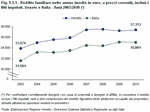
Table 9.3.1

Figure 9.3.2
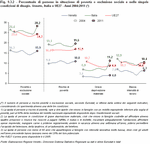
Figure 9.3.3
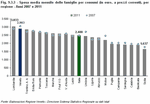
Figure 9.3.4
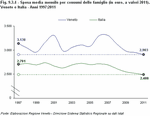
Figure 9.3.5
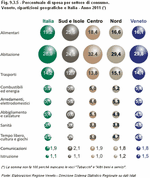
Table 9.3.2
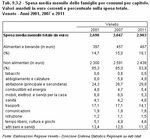
Table 9.3.3

Table 9.3.4
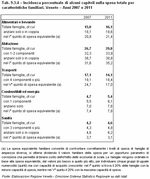
Figure 9.3.6
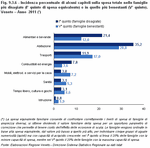
Table 9.3.5

Figure 9.3.7
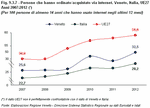
In 2012, above all in national journalism, there was remarkable coverage of a presumed phenomenon of foreign nationals fleeing Italy, which commentators related to the slugging pace of the economic crisis and the lack of employment, the main reason for immigrants originally settling in Italy. Here we will try to understand what is happening in the Veneto region, and whether migration flow dynamics are changing, drawing from data of the last official surveys, which show shifts in residence of foreign immigrants moving abroad and movements from one municipality and another on a national scale. In the case of the Veneto region, in 2011 there were 32,244 registered foreign nationals: these are newly arrived people, not previously resident in Italy, a figure that is still high, but less than two years before (nearly 19% fewer with respect to 2010), and a number clearly below the boom of newly registered residents of 2007 and 2008, due to the inclusion of Romania and Bulgaria in the European Union. At the same time, the number of foreign nationals deciding to leave Italy to move to other countries is on the increase; in the period 2009-2011 the outgoing flow reached on average 5 thousand people, while until a few years before less than 2 thousand were recorded. Nonetheless, the number of new immigrants is still nearly seven times those leaving, a positive figure that leads to an increase in the number of foreign nationals resident in the Veneto region and the overall national population. This figure is however falling, mainly due, as we have seen, to the change in arrivals from abroad rather than a substantial increase in those leaving the country. However it must be noted that the figures regarding foreign nationals moving away from Italy are still only partial, given the general approach of not notifying municipal authorities before departing. In fact in 2011 alone more than 15,000 foreign residents were removed from the council records due to unknown whereabouts. In any event, the tumultuous growth in foreign immigration, at the forefront in pre-crisis years, now seems to have shifted to a lower gear, though not totally at a standstill, considering that the international crisis has also had serious effects on poorer countries, the origin of most of these immigrants.
Similar dynamics, though with differing intensity, are found for the entire nation, in particular in the case of regions subject to most immigration such as Lombardy, Emilia Romagna, Piedmont and Tuscany. (Figure 9.4.1)
The foreign nationals moving away are mostly from the younger generation: on average they arrive in the Veneto region when aged under 30, to then decide to move to other countries when they reach the age of around 32; for many Italy is probably not their country of choice when making plans for immigration, but simply a point of transition.
As regards the countries of origin, the flow of immigrants from Romania into the Veneto region continues, which as well as representing the highest number of foreign nationals in this region, was also the top country for new arrivals in 2011 (+7,895 people). This phenomenon was due to the continuation of the "European expansion effect", which since 2007 has simplified council registration of EU citizens from Romania and Bulgaria. However Romanians are the most numerous foreign nationals moving abroad from our region, with over one thousand leaving in 2011, more than 20% of total foreign emigration. Further back lie the outgoing flows of Chinese, Moldavian and Moroccan nationals. (Figure 9.4.2)
The idea of moving away in search of better opportunities in the face of crisis seems to be a strategy that aims not only abroad but also within Italy's borders. Perhaps due to fewer ties with family, friends or communities, which normally play their part in resisting economic or other difficulties, foreign nationals are apparently more flexible in moving more often than the Italians, also between regions. With reference to data for the Veneto region, foreign nationals make up for more than a quarter of the interregional moves, while amounting to only 9.4% of the resident population. It is also worth noting that, unlike the past, in the last three years those leaving to live in other regions are higher in number than those arriving from other regions (the average interregional migration figure in the last three years is -433 people). The exchange regions, both incoming and outgoing, are furthermore those on the borders, i.e. Lombardy, Emilia Romagna and Friuli Venezia Giulia.
For a foreign national, without any protective social networks, the expression "to start a family" takes on an even more radical meaning and at the same time is indicative of an increasingly strong desire to choose their current place of residence as an "all-round" location, a place for life. In the Veneto region, families with foreign parents amount to 8.3% of the total (6.1% in Italy) and 25.6% of foreign nationals are aged under 18, the sign of strong roots in this territory; furthermore, this percentage is one of the highest of all regions, second only to Lombardy (26%). Foreign nationals do not only form families by reuniting with their spouse from their country of origin, but also form new families in Italy: married couples with at least one foreign national (3,197 in 2011) exceed 20% of the total, a percentage well above the national average of 13%. Children born from couples where the mother and/or father is foreign have now reached considerable figures, 27.5% of those born in the Veneto region, for a total of 12,480 in 2011, 0.7% more with respect to those of the previous year, driven above all by births in mixed couples with a foreign mother. The fertility rate of foreign women, through still on a high level (2.16 children per woman, compared to 1.27 of Veneto women), however shows a fall in numbers, especially when considering that in 2005 this was 2.69 children per woman, thus following the trend of Italians. This is in part attributable to life styles and reproductive behaviour of the host country, however, although it is still too soon to draw conclusions on this matter, it can be said that limiting the family numbers may constitute a strategy to deal with the uncertainty caused by the crisis.
A remarkable 38.1% of remittances from the Veneto region is made to the Asiatic area, a share constantly growing over time, to the extent of supplanting the flows towards eastern and central-eastern European countries (currently at 27.5%) and those towards Africa (17.8% of the total). In fact these are the most significant areas of destination for cash flows, given the substantial presence of citizens from these countries in our region: China, Bangladesh, India, Sri Lanka and Philippines in the case of Asia; Romania, Moldavia, Albania and the Ukraine in the case of eastern Europe; Morocco, Tunisia, Nigeria and Ghana in the case of Africa. The overall decrease in sums transferred in 2012 applies to all areas, and is more marked in the case of South America and North Africa (a decrease of around 20%) and a significant amount also for the 12 "new" EU countries and those from the Asiatic regions. (Table 9.4.1)
Similar dynamics, though with differing intensity, are found for the entire nation, in particular in the case of regions subject to most immigration such as Lombardy, Emilia Romagna, Piedmont and Tuscany. (Figure 9.4.1)
The foreign nationals moving away are mostly from the younger generation: on average they arrive in the Veneto region when aged under 30, to then decide to move to other countries when they reach the age of around 32; for many Italy is probably not their country of choice when making plans for immigration, but simply a point of transition.
As regards the countries of origin, the flow of immigrants from Romania into the Veneto region continues, which as well as representing the highest number of foreign nationals in this region, was also the top country for new arrivals in 2011 (+7,895 people). This phenomenon was due to the continuation of the "European expansion effect", which since 2007 has simplified council registration of EU citizens from Romania and Bulgaria. However Romanians are the most numerous foreign nationals moving abroad from our region, with over one thousand leaving in 2011, more than 20% of total foreign emigration. Further back lie the outgoing flows of Chinese, Moldavian and Moroccan nationals. (Figure 9.4.2)
The idea of moving away in search of better opportunities in the face of crisis seems to be a strategy that aims not only abroad but also within Italy's borders. Perhaps due to fewer ties with family, friends or communities, which normally play their part in resisting economic or other difficulties, foreign nationals are apparently more flexible in moving more often than the Italians, also between regions. With reference to data for the Veneto region, foreign nationals make up for more than a quarter of the interregional moves, while amounting to only 9.4% of the resident population. It is also worth noting that, unlike the past, in the last three years those leaving to live in other regions are higher in number than those arriving from other regions (the average interregional migration figure in the last three years is -433 people). The exchange regions, both incoming and outgoing, are furthermore those on the borders, i.e. Lombardy, Emilia Romagna and Friuli Venezia Giulia.
Settling down, starting a family
Immigrant mobility is basically a reflection of careful evaluation of a location, environmental circumstances and opportunities that arise from these. It represents a strong sensitivity to all that can be improved or all that may worsen in one's existence; a sensitivity that foreign nationals need to acquire in haste, in a certain sense "on site". While on the one hand receptivity to external signals may be seen as an acquired personal quality, on the other the interpretation and response are changeable (whether to stay or go), based on diverse personal circumstances: whether or not to start a family, whether home owners or not, whether young or old, whether part of a social network or not. Research by Censis (Note 12) looks into the expectations of immigrants in Italy for the next ten years and, despite the difficult period, a general sense of optimism arises regarding a variety of areas, even when problematic, such as work, unlike those expressed by the Italians. The most dynamic aspect regards increasing expectations of social success when faced with personal commitment and sacrifice: 72% of foreign nationals, in Italy and in the North East are convinced that the best will succeed in the world of work, no longer confined to low profile roles. This conviction extends also to the children, the sign of projected inter-generational well-being in ascent, the basis of which is "rolling your sleeves up" and making a concerted effort, also at school, in which many have expressed great faith, given that 76% of immigrants (81% in the North East) hope that their children will graduate from university. The weakest link felt on a widespread level is social integration; only 28.5% expect their children to be fully integrated without any substantial diversity with native Italians, while 54.3% believe that over the next few years, immigrants will continue to be kept on the margins without rights. This is a hard-hitting figure, but mitigated by more positive expectations for a "horizontal" type of integration, created by relations and day-to-day living, which the foreign nationals themselves desire, wish to promote and try to improve through friendly and neighbourly relations (60%) and through cultural or volunteering initiatives (50%). 72% of foreign nationals express a wish to stay in Italy also over the next ten years, and more than 60% would like to renovate or buy their own home in the city where they live, all signs of an intention to settle down, be part of a community and think about starting a family. For a foreign national, without any protective social networks, the expression "to start a family" takes on an even more radical meaning and at the same time is indicative of an increasingly strong desire to choose their current place of residence as an "all-round" location, a place for life. In the Veneto region, families with foreign parents amount to 8.3% of the total (6.1% in Italy) and 25.6% of foreign nationals are aged under 18, the sign of strong roots in this territory; furthermore, this percentage is one of the highest of all regions, second only to Lombardy (26%). Foreign nationals do not only form families by reuniting with their spouse from their country of origin, but also form new families in Italy: married couples with at least one foreign national (3,197 in 2011) exceed 20% of the total, a percentage well above the national average of 13%. Children born from couples where the mother and/or father is foreign have now reached considerable figures, 27.5% of those born in the Veneto region, for a total of 12,480 in 2011, 0.7% more with respect to those of the previous year, driven above all by births in mixed couples with a foreign mother. The fertility rate of foreign women, through still on a high level (2.16 children per woman, compared to 1.27 of Veneto women), however shows a fall in numbers, especially when considering that in 2005 this was 2.69 children per woman, thus following the trend of Italians. This is in part attributable to life styles and reproductive behaviour of the host country, however, although it is still too soon to draw conclusions on this matter, it can be said that limiting the family numbers may constitute a strategy to deal with the uncertainty caused by the crisis.
Helping the family of origin
Those who by necessity settle in a foreign country know only too well the difficulties and often critical conditions of the family they leave behind in their country of origin; besides, not only the global economic crisis has affected developing countries but, as highlighted by a study published by the Initiative for Policy Dialogue of Columbia University in collaboration with the South Centre (Note 13), the fiscal tightening policies have been more severe in poorer countries, leading to more burdens on the cost of living for the more vulnerable sectors of the population. It should also be noted that people often emigrate thanks to the support (not only financial) of the family, and emigration represents an investment as part of a plan to rise from poverty, which is more often collective and family oriented rather than individual. Thus the immigrants' idea of "making their fortune" regards above all the ability to send money home. Data from the Bank of Italy, which includes cross border transactions between two physical parties via an institute of credit or other authorised intermediary (Note 14), can provide an estimate of the cash flow between Italy and abroad. While 2010 is an exception due to a slight variation, from 2005 to 2011 the sum of payments made to other countries has progressively increased, both on a national scale and in all regions, given the increased presence of foreign nationals in Italy. However 2012 showed a quite substantial halt to this process, virtually all over Italy; records show outgoing payments of 423.3 million euro from the Veneto region, a drop of more than 15% compared to the previous year (a reduction of 7.6% in Italy). This data gives cause for concern when calculating that on average one foreign national in our region managed to send home more than one thousand euro a year in 2007, while in 2012 this was estimated (Note 15) at 813 euro. This trend of progressive reduction in average imports, though found on different levels, is similar for all regions in Italy: the crisis has also meant that foreign nationals struggle to save, - in fact they suffer in the same way and more so than Italians from the increase in unemployment - but it may also be due to the introduction of stamp duties on money transfers introduced at the end of 2011, implemented for several months until April 2012 (Note 16). (Figure 9.4.3)A remarkable 38.1% of remittances from the Veneto region is made to the Asiatic area, a share constantly growing over time, to the extent of supplanting the flows towards eastern and central-eastern European countries (currently at 27.5%) and those towards Africa (17.8% of the total). In fact these are the most significant areas of destination for cash flows, given the substantial presence of citizens from these countries in our region: China, Bangladesh, India, Sri Lanka and Philippines in the case of Asia; Romania, Moldavia, Albania and the Ukraine in the case of eastern Europe; Morocco, Tunisia, Nigeria and Ghana in the case of Africa. The overall decrease in sums transferred in 2012 applies to all areas, and is more marked in the case of South America and North Africa (a decrease of around 20%) and a significant amount also for the 12 "new" EU countries and those from the Asiatic regions. (Table 9.4.1)









